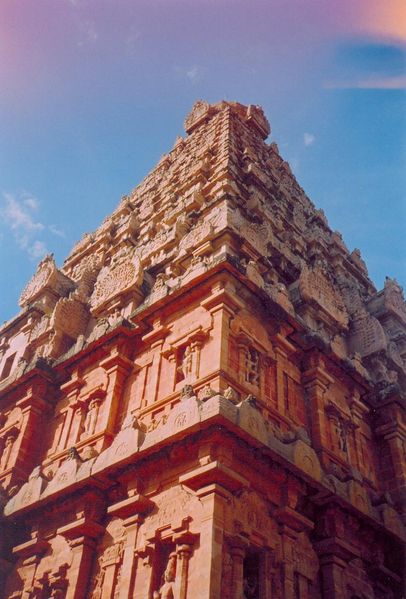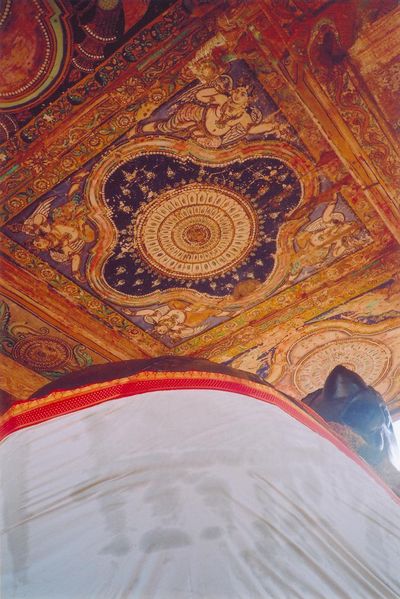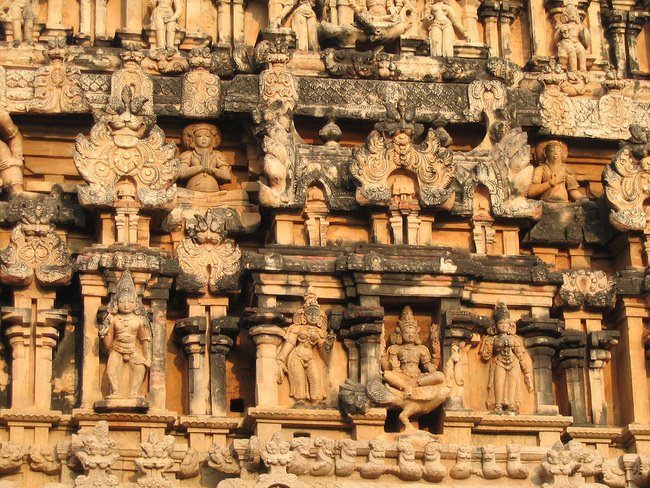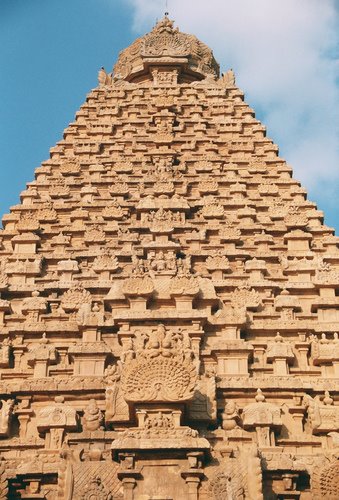




The so-called Big Temple, the Brihadisvara at Thanjavur (Tanjore) in the Indian state of Tamil Nadu, was built between a.d. 1003 and 1010. It is the epitome of Dravidian temple architecture and a wonderful gallery of South Indian art and craft. Vijayalaya Cholan (a.d. 846–871), founder of the Chola dynasty, chose the well-established settlement beside the River Kaveri as his capital, and for four centuries Chola influence on Indian religion, culture, art, and architecture spread from the royal city. Thanjavur is now a country town of about 200,000 people.
Chola dominion was extended under Vijayalaya’s son Aditya I, the beginning of an empire that reached its apogee of power and prosperity under the greatest Chola ruler, Rajaraja (Arunmozhivarma), soon after he became king in a.d. 985. By about 1005 he subjugated much of southern India, and the dynasty eventually controlled the Malay Peninsula, Sumatra, and parts of Sri Lanka. His conquests complete, until his death in 1014 Rajaraja turned his thoughts to religion and the arts, initiating many temples and replacing older brick shrines with ones of stone.
Although remarkably open-minded in religious matters, Rajaraja was a pious devotee of Siva, and the greatest of his cultural achievements was a masterpiece of South Indian art and architecture, the Brihadisvara at Thanjavur (also known as Peruvudaiyar Koil). He named it Rajarajeswaram. The temple precinct occupies most of the Sivaganga Fort, which was enclosed within perimeter walls in the sixteenth century. The fort is now bounded on the east and west by moats, and on the south by the Grand Anaicut Channel, part of an extensive eleventh-century irrigation, system. To the north is the Sivaganga Garden, which also postdates the temple.
The Brihadisvara Temple stands within two concentric rectangular spaces. The outer court, measuring 793 by 397 feet (238 by 119 meters), is entered at its eastern end through a magnificent towered gatehouse, flanked by shrines dedicated to Ganapathi and Mrurgan. Facing the outer gatehouse is a similar structure, 90 feet (27 meters) high, that gives access to the carefully planned 500-by-250-foot (150-by-75-meter) stone- and brick-paved inner courtyard, at whose western end stands the main shrine of Sri Brihadisvara.
The temple proper, so to speak, is a complex suite of several elements. Although they are separate structures, they form an entity, the garbhagriham—that is, the holy of holies—surrounded by a 1,500-foot (450-meter) colonnaded cloister (prakaram). The cloister’s two levels, although, dimly lit, are decorated with brilliantly colored frescoes from the Chola period, depicting the lives of the sixty-four Nayanmars (Saivite saints), the sacred bull (nandi), and the ceremonial mount of Siva. There are also sculptured panels showing the Bharata Natyam dance postures (karanas) and the manifestations of Siva known as Sivalingams. Altogether, there are about 250 Sivalingams throughout the temple complex: the largest, 29 feet (8.7 meters) high, is set in a two-story sanctum. The main shrine also includes a large hall with open aisles (Maha-mandapam), intended for religious discourse; another terraced hall enclosing the shrine of Sri Thyagarajar; and various ancillary halls for storing religious trappings and housing musicians. Standing in an elaborately decorated open hall in the inner court is a massive monolithic nandi, 12 feet (3.6 meters) high and nearly 20 feet (6 meters) long. There are several subshrines in the complex, but only one seems to have been built at the same time as the main temple.
The inner court is dominated by the 96-foot-square (29-meter) granite base of the vimana, a tower that rises through fourteen diminishing stories to a height of almost 220 feet (66 meters). Its facades are encrusted with hundreds of stucco figures of the myriad Hindu gods, standing in niches between carefully wrought pilasters. The vimana is crowned with an octagonal dome (sikaram) resting on an 80-ton (7.3-tonne) granite structure (contrary to popular accounts, it is not a single block), enriched with nandis at each corner. Rising above the dome is a 12.5-foot (3.8-meter) finial (kalasam) ending in a copper pot overlaid with gold plate, a gift of King Rajaraja. The generous endowments of the devout king and his sister Kundavai to the temple are recorded in inscriptions on the walls of the vimana. Everywhere, the surfaces of the building provide a vehicle for Chola art, making the Brihadisvara more than just an architectural masterpiece—it is also a magnificent repository of the highest artistic and craft skills of a golden age. Someone has said that the Chola artists conceived like giants and finished like jewelers. The temple was added to UNESCO’s World Heritage List in 1987.
Beginning with Rajaraja the Great, the piety of the Chola dynasty is evidenced by more than seventy temples built in and near Thanjavur over the next two centuries. Noteworthy among them were Gangaikondacholisvaram Temple at Gangaikonda Cholapuram, whose vimana was a little shorter than that at Thanjavur; the more diminutive Airavateswarar Temple at Darasuram, described by one critic as “a sculptor’s dream re-lived in stone”; and the Kampahareswarar Temple at Tribhuvanam. In each of the four, the vimana was taller—usually much taller—than the towers of the entrance gates; after them, Chola architects returned to their traditional forms, in which the relative heights were reversed.
No comments:
Post a Comment